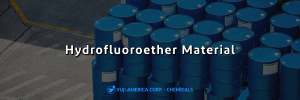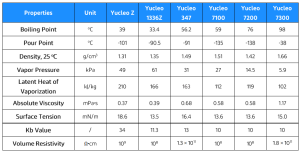Request A Quote
Our business is most valuable when it helps our customers. Please fill out the form with as much detail as possible so we can respond with the most helpful solution.

In the quest for more environmentally friendly alternatives to traditional chemicals, hydrofluoroethers (HFEs) have emerged as a promising solution. HFEs are a class of compounds that combine fluorine and hydrogen atoms with oxygen, and they offer a range of applications across various industries. In this article, we will delve into what HFEs are, their unique properties, and their potential to revolutionize the chemical landscape.
Hydrofluoroethers, often abbreviated as HFEs, belong to the larger family of fluorinated organic compounds. They are characterized by the presence of fluorine (F), hydrogen (H), and oxygen (O) atoms in their molecular structure. HFEs are colorless, odorless, and non-flammable, making them versatile candidates for a variety of applications.
HFC and HCFC’s are synthetic hydrocarbons that are used in refrigerants, foams, propellants, and more. They were initially developed to replace CFC (Chlorofluorocarbons), which are harmful chemicals found to deplete the ozone layer. HCFCs were introduced in the 1980s and had lower ozone-depleting potential compared to CFCs. HFCs, introduced in the early 1990s, had zero ozone-depleting potential. HCFCs and HFCs were developed as alternatives to chlorofluorocarbons (CFCs), which were found to deplete the ozone layer.
The U.S. began phasing out HCFCs, particularly HCFC-22, used in air conditioning and refrigeration. The Clean Air Act Amendments of 1990 set the framework for these phase-out efforts, and subsequent regulations implemented strict control measures. As HCFCs were phased out due to their potential impact on the ozone layer, HFCs gained popularity as replacements in various applications due to their zero ozone-depleting potential. However, it later became evident that HFCs have a high global warming potential (GWP).
The U.S. joined the Kigali Amendment to the Montreal Protocol in 2019. This amendment aims to phase down the use of HFCs worldwide, as they are potent greenhouse gases contributing to climate change. The U.S. Environmental Protection Agency (EPA) has implemented regulations to reduce HFC emissions, including the Significant New Alternatives Policy (SNAP) program, which identifies acceptable substitutes with lower GWP. The U.S. continues to work toward reducing the use of HFCs and transitioning to more environmentally friendly alternatives, such as hydrofluoroether (HFEs) and hydrofluoroolefins (HFOs) and natural refrigerants, to mitigate their impact on ozone depletion and climate change.
As the world shifts toward more sustainable and eco-conscious practices, hydrofluoroethers are well-positioned to play a vital role in this transition. Their low environmental impact, combined with their versatility, opens doors to innovative solutions in a variety of industries. Researchers and engineers continue to explore new applications for HFEs, ensuring a brighter and more sustainable future. In conclusion, hydrofluoroethers represent a promising step forward in the pursuit of environmentally friendly chemical alternatives. Their unique properties and wide range of applications make them a compelling choice for industries seeking to reduce their impact on the planet. As technology and awareness continue to evolve, HFEs are likely to become even more integral to the global effort to protect our environment while meeting our chemical and industrial needs.

Our business is most valuable when it helps our customers. Please fill out the form with as much detail as possible so we can respond with the most helpful solution.